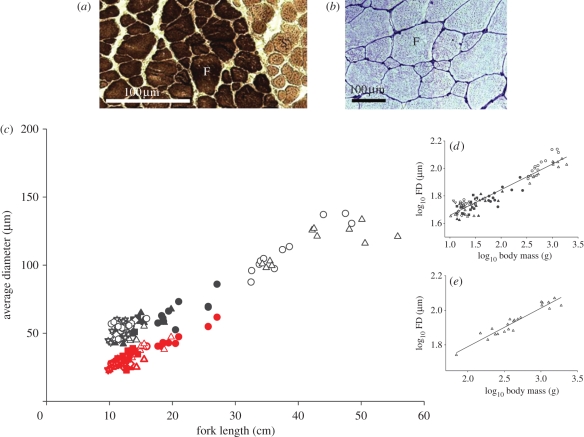Figure 2.
Axial muscle structure in wild-caught and laboratory-reared Arctic charr. (a) Cross section of a wild-caught dwarf charr from Álftavatn stained for myosin ATPase activity, illustrating darkly stained fast (F) and lightly stained slow fibres (S). (b) Cross section of a laboratory-reared dwarf charr from Álftavatn stained with haematoxylin showing the mosaic of fibre diameters (FDs) in fast muscle (F). (c) The relationship between body size and average FD for Arctic charr. Large-bodied populations: Lake Thingvallavatn large benthic morph (unfilled circles) and piscivorous morph (unfilled upright triangles) (data from Johnston et al. [6]). Dwarf populations in sympatry: Lake Thingvallavatn small benthic morph (data from Johnston et al. [6]) (filled circles), Álftavatn (filled upright triangles) and Silungapollur (filled squares). Dwarf populations in allopatry: Kaldárbotnar (unfilled circles), Miðhúsaskógur (unfilled upright triangles), Straumsvík (unfilled diamonds), Hrauná (unfilled stars) and Sílatjörn (unfilled inverted triangles). The equivalent red symbols show the estimated average FD calculated assuming FNmax was unchanged from the ancestral condition (see text for details). (d) Insert shows the log10 average fibre number plotted against log10 body mass for large-bodied and dwarf charr. Symbols are as for (c). (e) The scaling relationship for FD for the Thingvallavatn piscivorous morph including individuals at different stages of muscle fibre recruitment.

